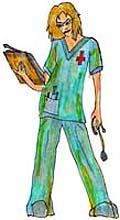 Chances are when you hear this phrase you picture television commercials with happy children drinking glasses of the white drink or your favorite celebrity with a milk mustache. But what you probably don’t know is despite the fact Americans consume more cows’ milk than almost every country in the world, we also have one of the highest rates of osteoporosis.
Chances are when you hear this phrase you picture television commercials with happy children drinking glasses of the white drink or your favorite celebrity with a milk mustache. But what you probably don’t know is despite the fact Americans consume more cows’ milk than almost every country in the world, we also have one of the highest rates of osteoporosis.
How can this be? If milk is so good for our bones and we’re consuming so much of it, why do we have more osteoporosis than our underdeveloped counterparts? According to medterms.com, osteoporosis is defined as, “a thinning of the bones with reduction in bone mass.” Essentially, your bones begin to look like a sponge, with tiny holes in them, and as you can imagine, this is not a good thing. Studying the rate of hip fracture is commonly used as an indicator of osteoporosis. While it was once thought that when an older person broke a hip, it was because of a bad fall, but we now know just the opposite may be true. When a person’s bones are thinned due to osteoporosis, it is entirely possible for a bone, such as the hip to break, causing a fall. And this is of particular concern to women. One in two women over the age of fifty will have an osteoporosis related fracture in their lifetime.
So what does all this have to do with those popular milk ads? A lot. More than 35 years ago a study (actually a group of studies) was started, which led to the book, “The China Study” by T. Colin Campbell, PhD. After compiling all of the information, researchers found that animal products, including milk, yogurt and cheese increase the acidity in our blood and tissues because of the high content of protein. Our bodies don’t like acid so they begin to try to neutralize it
In order to neutralize acid, the body needs calcium. And where is the best place to find calcium in large amounts? You guessed it … your bones. So your body begins to pull calcium from your bones, which weakens them, putting them at high risk for osteoporosis and secondarily to fracture.
Harvard Willett, M.D., professor of preventative medicine at the Harvard School of Public Health agrees. He was a lead researcher in the Nurses Health Study, a landmark study that followed approximately 122,000 nurses. What they found has turned the medical community upside-down. Their report stated they had found no evidence that women who consumed dairy products had any advantage when it came to hip fracture or osteoporosis. And, in the end, they made recommendations, which included taking supplements and consuming calcium rich foods such as broccoli, tofu and sesame seeds.
Seems like this new information would have us all running to the doctor to find out what we should be doing. But the truth is — this isn’t a new revelation at all. The fact that animal products increase metabolic acid and decrease bone health has been known for more than a hundred years. The idea was first suggested as far back as the 1880s and was documented as long ago as the 1920s.
So, what’s a woman to do? Below are a few recommendations to ensure strong bones, courtesy of strongbones.org.
Stay physically active: Weight-bearing exercise helps build strong bones. Walking, jogging, dancing, playing racquetball or tennis are among the best exercises to promote good bone health. Find a physical activity you love and do it often. Build physical activity into your every day life. The possibilities are endless. Be creative. Your bones will love you for it.
Get calcium: Calcium is found in many plant foods including beans and leafy green vegetables. If you can’t get your calcium from foods, take a calcium supplement (between 1000 and 1300mg/day). Your body also needs Vitamin D in order to absorb calcium (between 400 and 800 IU/day).
Avoid smoking and alcohol: Both are risk factors for osteoporosis. Smoking has been associated with lower bone density. High levels of alcohol consumption are associated with osteoporosis so it’s best to avoid it.
Talk to your doctor about bone health: Get prevention tips from your doctor. Osteoporosis is sometimes called the “silent disease” because a person often doesn’t know they have it until a fracture occurs. So talk to your doctor not only about prevention but also about appropriate tests such as a Bone Mineral Density (BMD) test. Some medications leach calcium from your bones, so ask your doctor about the medications you are currently taking.
The bad news is osteoporosis affects more than 20 million people in the U.S. and causes 1.5 million fractures each year. For 20 percent of those, the fracture will lead to death. Another 40 percent will require long term nursing care. Those are grim statistics. But there is good news too.
According to the National Osteoporosis Foundation, osteoporosis is considered a preventable disease for most people. With some simple steps you can ensure future bone health. Be good to your bones today and, in turn, they’ll be good to you in the future.
